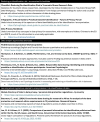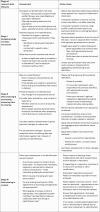Sharing traumatic stress research data: assessing and reducing the risk of re-identification
- PMID: 40387730
- PMCID: PMC12090263
- DOI: 10.1080/20008066.2025.2499296
Sharing traumatic stress research data: assessing and reducing the risk of re-identification
Abstract
Background: FAIR Data practices support data sharing and re-use and are essential for advancing science and practice to benefit individuals, families, and communities affected by trauma. In traumatic stress research, as in other health and social science research, ethical, legal, and regulatory frameworks require careful attention to data privacy. Most traumatic stress researchers are aware of basic methods for de-identifying/anonymising datasets that are to be shared. But our field has not generally made use of systematic, data analytic approaches to reduce the risk of re-identification of study participants or disclosure of personal or sensitive information.Objective: To facilitate safe and ethical data sharing by better preparing traumatic stress researchers to systematically assess and reduce re-identification risk using contemporary data analytic methods.Method: In two case studies using publicly available trauma research datasets from international, multi-language projects, we applied a systematic approach guided by the Checklist for Reducing Re-Identification Risk in Traumatic Stress Research Data.Results: For each case study dataset, we identified specific recommended actions to further reduce the risk of re-identification, and we then communicated these recommendations to the original investigators. After implementing the recommended changes, each dataset is judged to be at very low re-identification risk.Discussion: The particular nature of traumatic stress research, i.e. its content, data, and study designs, can influence the likelihood and potential impact of re-identification or disclosure. The two worked case examples in this paper demonstrate the utility of applying a systematic approach to assess and further mitigate re-identification risk in shared datasets. At each stage of the research data lifecycle, there are research practices and choices relevant to reducing re-identification risk. This paper presents practical tips for research teams to facilitate FAIR data practices while attending to data privacy.
Antecedentes: Las prácticas de datos FAIR sustentan el intercambio y la reutilización de datos, y son esenciales para el avance de la ciencia y la práctica en beneficio de las personas, familias y comunidades afectadas por el trauma. En la investigación sobre estrés traumático, al igual que en otras investigaciones de ciencias sociales y de la salud, los marcos éticos, legales y regulatorios exigen una cuidadosa atención a la privacidad de los datos. La mayoría de los investigadores en estrés traumático conocen los métodos básicos para desidentificar/anonimizar los conjuntos de datos que se compartirán. Sin embargo, nuestro campo generalmente no ha utilizado enfoques de análisis de datos sistemáticos para reducir el riesgo de reidentificación de los participantes del estudio o la divulgación de información personal o sensible.
Objetivo: Facilitar el intercambio seguro y ético de datos mediante una mejor preparación de los investigadores en estrés traumático para evaluar sistemáticamente y reducir el riesgo de reidentificación mediante métodos contemporáneos de análisis de datos.
Método: En dos estudios de caso que utilizaban conjuntos de datos de investigación provenientes de proyectos internacionales y multilingües sobre trauma, disponibles públicamente, aplicamos un enfoque sistemático guiado por la Lista de Verificación para la Reducción del Riesgo de Reidentificación en Datos de Investigación sobre Estrés Traumático.
Resultados: Para cada conjunto de datos de estudio de caso, identificamos acciones recomendadas específicas para reducir aún más el riesgo de reidentificación y las comunicamos a los investigadores originales. Tras implementar los cambios recomendados, cada conjunto de datos se considera con un riesgo de reidentificación muy bajo.
Discusión: La naturaleza particular de la investigación sobre estrés traumático, es decir, su contenido, datos y diseños de estudio, puede influenciar la probabilidad e impacto potencial de la reidentificación o divulgación. Los dos ejemplos de casos trabajados en este artículo demuestran la utilidad de aplicar un enfoque sistemático para evaluar y mitigar aún más el riesgo de reidentificación en conjuntos de datos compartidos. En cada etapa del ciclo de vida de los datos de investigación, existen prácticas y opciones de investigación relevantes para reducir el riesgo de reidentificación. Este artículo presenta consejos prácticos a los equipos de investigación para facilitar las prácticas de datos FAIR, respetando al mismo tiempo la privacidad de los datos.
Keywords: Datos FAIR; FAIR data; anonimización; anonymisation; data sharing; de-identification; desidentificación; intercambio de datos; re-identification risk; riesgo de reidentificación.
Plain language summary
Data sharing and re-use help to advance science and practice, benefiting individuals, families, and communities impacted by trauma.Safe and ethical data sharing requires that datasets be effectively de-identified or anonymized to protect participant privacy.This paper presents and demonstrates a systematic approach and contemporary analytic methods to assess and reduce the risk of re-identification of participants when traumatic stress research data are shared.
Conflict of interest statement
No potential conflict of interest was reported by the author(s).
Figures
References
-
- Campbell, R., Goodman-Williams, R., Engleton, J., Javorka, M., & Gregory, K. (2023). Open science and data sharing in trauma research: Developing a trauma-informed protocol for archiving sensitive qualitative data. Psychological Trauma: Theory, Research, Practice, and Policy, 15(5), 819. DOI:10.1037/tra0001358 - DOI - PubMed
-
- Child Trauma Data Collection . (2024). https://www.icpsr.umich.edu/web/DSDR/series/2420.
-
- Core Trust Seal . (2020). Core trust seal: Why certification? Retrieved February 4, 2020, from https://www.coretrustseal.org/why-certification/.
-
- Elliot, M., Mackey, E., & O'Hara, K. (2020). The anonymisation decision-making framework 2nd edition: European practitioners’ guide. UKAN Publications. https://ukanon.net/wp-content/uploads/2024/01/adf-2nd-edition-european-p...
Publication types
MeSH terms
LinkOut - more resources
Full Text Sources
Other Literature Sources



